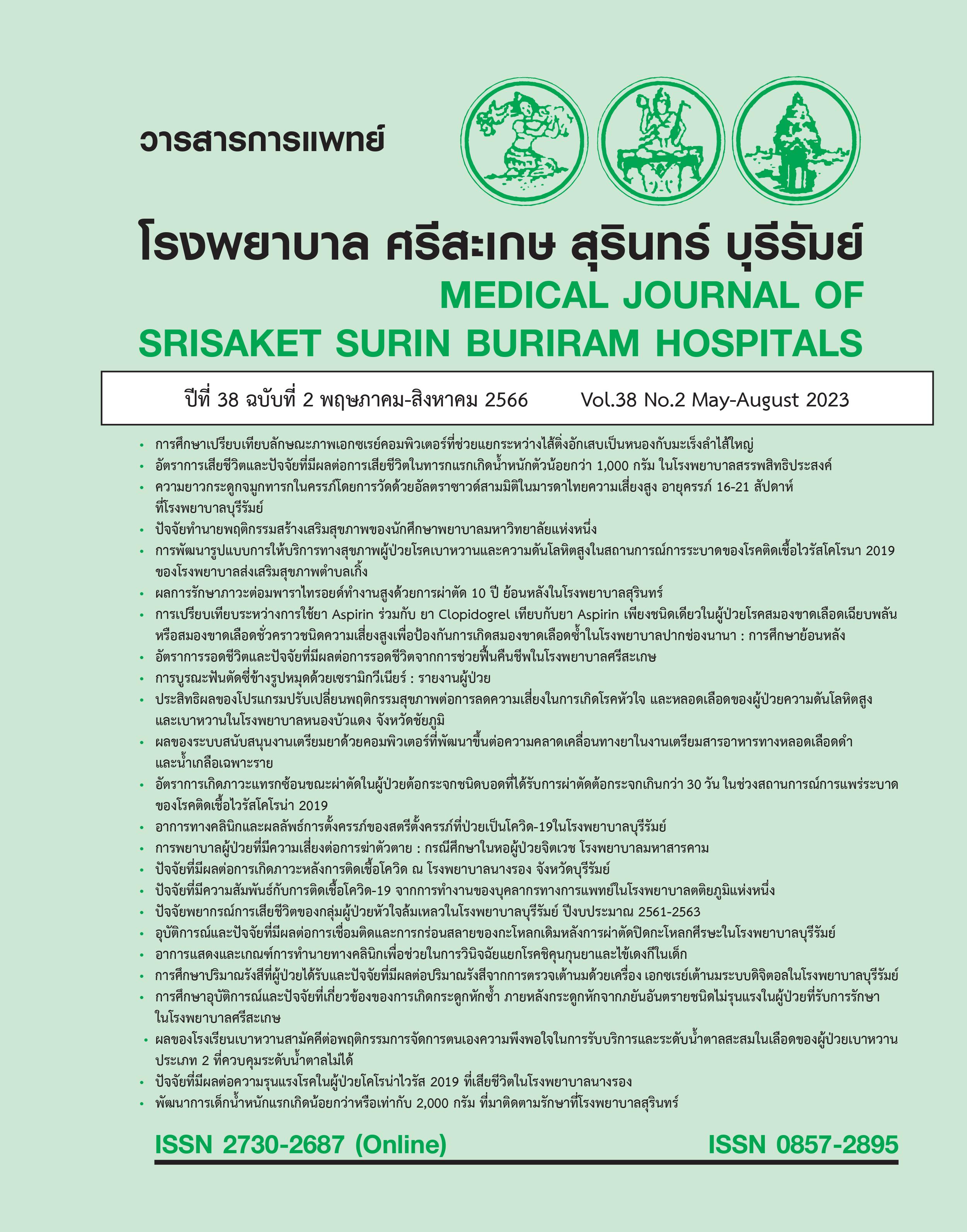พัฒนาการเด็กน้ำหนักแรกเกิดน้อยกว่าหรือเท่ากับ 2,000 กรัม ที่มาติดตามรักษาที่โรงพยาบาลสุรินทร์
Main Article Content
บทคัดย่อ
หลักการและเหตุผล: ปัจจุบันทารกแรกเกิดน้ำหนักตัวน้อยมีโอกาสรอดชีวิตมากขึ้น ถือเป็นเด็กกลุ่มเสี่ยงต่อการมีพัฒนาการล่าช้าโดยเฉพาะทารกแรกเกิดน้ำหนักน้อยกว่าหรือเท่ากับ 2,000 กรัม
วัตถุประสงค์: เพื่อศึกษาพัฒนาการ ผลการกระตุ้นพัฒนาการ และปัจจัยที่มีผลต่อพัฒนาการล่าช้าของทารกแรกเกิดน้ำหนักตัวน้อยกว่าหรือเท่ากับ 2,000 กรัม ที่มาติดตามที่คลินิกเจ้าตัวน้อยโรงพยาบาลสุรินทร์
วิธีการศึกษา: เป็นการศึกษาย้อนหลังเชิงพรรณนา รวบรวมข้อมูลทารกแรกเกิดน้ำหนักตัวน้อยกว่าหรือเท่ากับ 2,000 กรัม ที่เกิดระหว่างวันที่ 1 มกราคม พ.ศ.2561 ถึงวันที่ 31 ธันวาคม พ.ศ.2563 ติดตามจนอายุครบ 2 ปี บันทึกข้อมูลทั่วไป ภาวะแทรกซ้อน ผลการคัดกรองพัฒนาการโดยใช้เครื่องมือเดนเวอร์สองที่อายุ 2 4 6 9 12 18 และ 24 เดือน ผู้ที่มีพัฒนาการล่าช้าจะได้รับการกระตุ้นพัฒนาการและติดตามใน 1 เดือน บันทึกผลและนำมาวิเคราะห์
ผลการศึกษา: ทารกเข้าเกณฑ์ 157 ราย เป็นเพศชาย 83 คน ร้อยละ 52.9 อายุครรภ์เฉลี่ย 32.6 (± 2.9) สัปดาห์ น้ำหนักแรกเกิดเฉลี่ย 1,584.2 (± 282.3) กรัม ผลการคัดกรองพัฒนาการที่อายุ 2 4 6 9 12 18 และ 24 เดือน พบว่ามีพัฒนาการล่าช้า ร้อยละ 7.8 ร้อยละ 7.2 ร้อยละ 8.7 ร้อยละ 16.9 ร้อยละ 9.7 ร้อยละ 10.2 และ ร้อยละ 15.1 ตามลำดับ โดยเฉพาะพัฒนาการด้านภาษาพบว่ามีความล่าช้ามากที่สุด ที่อายุ 24 เดือนมีผู้มาติดตามทั้งหมด 126 คน หลังได้รับการกระตุ้นมีพัฒนาการล่าช้ามากกว่าหรือเท่ากับ 2 ใน 4 ด้านจำนวน 14 คน (ร้อยละ 11.1), พัฒนาการด้านภาษาล่าช้าด้านเดียว 2 คน (ร้อยละ 1.6 ) และมีพัฒนาการกลับมาปกติ 3 คน (ร้อยละ 2.4) จากการศึกษาพบปัจจัยเดียวที่มีผลอย่างเป็นนัยสำคัญต่อพัฒนาการล่าช้าคืออายุครรภ์น้อยกว่าหรือเท่ากับ 28 สัปดาห์
สรุป: ทารกแรกเกิดน้ำหนักตัวน้อยกว่าหรือเท่ากับ 2,000 กรัมส่วนใหญ่มีพัฒนาการสมวัยที่อายุ 24 เดือน การวินิจฉัยได้รวดเร็วและให้การกระตุ้นพัฒนาการในทันทีจึงมีความสำคัญและควรตระหนักในการดูแลตั้งแต่ช่วงตั้งครรภ์เพื่อป้องกันการคลอดก่อนกำหนด
Article Details

อนุญาตภายใต้เงื่อนไข Creative Commons Attribution-NonCommercial-NoDerivatives 4.0 International License.
เอกสารอ้างอิง
Vilanova CS, Hirakata VN, de Souza Buriol VC, Nunes M, Goldani MZ, da Silva CH.The relationship between the different low birth weight strata of newborns with infant mortality and the influence of the main health determinants in the extreme south of Brazil. Popul Health Metr 2019;17(1):15. doi: 10.1186/s12963-019-0195-7.
Sangtawesin V, Singarj Y, Kanjanapattanakul W. Growth and development of very low birth weight infants aged 18-24 months at Queen Sirikit National Institute of Child Health. J Med Assoc Thai 2011;94 Suppl 3:S101-6. PMID: 22043761
Chaudhari S, Otiv M, Khairnar B, Pandit A, Hoge M, Sayyad M. Pune low birth weight study - birth to adulthood - cognitive development. Indian Pediatr 2013;50(9):853-7. doi: 10.1007/s13312-013-0236-4.
Fernández Carrocera LA, Turcio Cortázar E, Garza Morales S, Rodríguez Pérez L, Udaeta Mora E. [Alterations in neuro-development in the 1st year of life in newborn infants weighing 2000 grams or less at birth]. Spanish. Neurologia 1992;7(5):98-101.PMID: 1382486
Upadhyay RP, Naik G, Choudhary TS, Chowdhury R, Taneja S, Bhandari N, et al. Cognitive and motor outcomes in children born low birth weight: a systematic review and meta-analysis of studies from South Asia. BMC Pediatr 2019;19(1):35. doi: 10.1186/s12887-019-1408-8.
Longo S, Caporali C, Pisoni C, Borghesi A, Perotti G, Tritto G, et al.Neurodevelopmental outcome of preterm very low birth weight infants admitted to an Italian tertiary center over an 11-year period. Sci Rep 2021;11(1):16316. doi: 10.1038/s41598-021-95864-0.
Smith L, Somner FF, von Tetzchner S. A longitudinal study of low birthweight children: reproductive, perinatal, and environmental precursors of developmental status at three years of age. Semin Perinatol 1982;6(4):294-304.PMID: 7156987
Ghaseminejad A, Niknafs P. Distribution of retinopathy of prematurity and its risk factors. Iran J Pediatr 2011;21(2):209-14.PMID: 23056789
Khatami, S. F. and Yousefi, A. and Bayat, G. F. and Mamuri, G. (2008) Retinopathy of prematurity among 1000-2000 gram birth weight Newborn infants. Iran J Pediatr 2008;18(2):137-42.
Poonual W, Navacharoen N, Kangsanarak J, Namwongprom S. Risk factors for hearing loss in infants under universal hearing screening program in Northern Thailand. J Multidiscip Healthc 2015;9:1-5. doi: 10.2147/JMDH.S92818.
Xiong X, Wightkin J, Magnus JH, Pridjian G, Acuna JM, Buekens P. Birth weight and infant growth: “catch-up” vs. “slow-down” growth. Ann Epidemiol 2005;15(8):658.
https://doi.org/10.1016/j.annepidem.2005.07.034
Pedersen SJ, Sommerfelt K, Markestad T. Early motor development of premature infants with birthweight less than 2000 grams. Acta Paediatr 2000;89(12):1456-61. doi: 10.1080/080352500456642.
Lammertink F, Vinkers CH, Tataranno ML, Benders MJNL. Premature Birth and Developmental Programming: Mechanisms of Resilience and Vulnerability. Front Psychiatry 2021;11:531571. doi: 10.3389/fpsyt.2020.531571.
Chaudhari S, Otiv M, Chitale A, Pandit A, Hoge M. Pune low birth weight study--cognitive abilities and educational performance at twelve years. Indian Pediatr 2004;41(2):121-8. PMID: 15004297
Rahman MS, Takahashi N, Iwabuchi T, Nishimura T, Harada T, Okumura A, et al. Elevated risk of attention deficit hyperactivity disorder (ADHD) in Japanese children with higher genetic susceptibility to ADHD with a birth weight under 2000 g. BMC Med 2021;19(1):229. doi: 10.1186/s12916-021-02093-3.
Lampi KM, Lehtonen L, Tran PL, Suominen A, Lehti V, Banerjee PN, et al. Risk of autism spectrum disorders in low birth weight and small for gestational age infants. J Pediatr 2012;161(5):830-6. doi: 10.1016/j.jpeds.2012.04.058.


